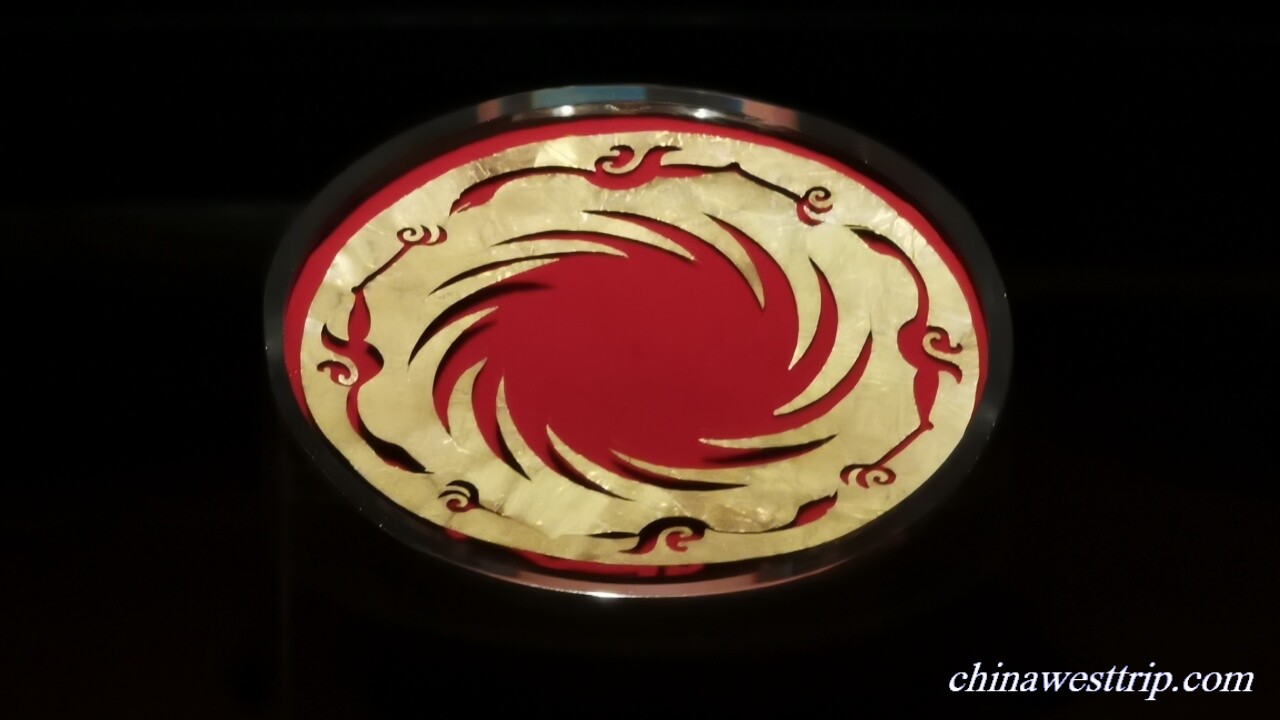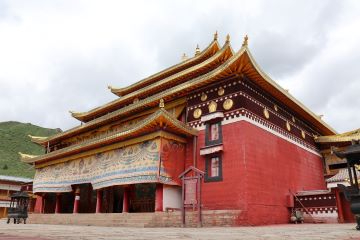the Sun and Immortal Birds Gold Foil
Name in Chinese: 金沙 Jīn Shā [dʒin sa:]
Duration of Tour: Two Hours
Location: No.2, Jinsha Yizhi Road, Qingyang District, Chengdu, Sichuan Province
Highlights: Unveiling the Mystery of the Ancient Shu Civilization
Must-see Sightseeing Spots: the Relic Site Hall and the Exhibition Hall
Reputations: One of China’s Top-class Museums, A National Four-star Scenic Area
Jinsha Ruins were discovered on February 8, 2001, in urban Chengdu. The site covers an area of 5 square meters(1,236 acres). The ruins could be dated back to the 12th century B.C. to 17th century B.C.. Archaeologists believe that the site was the capital of the Ancient Shu Kingdom. The Ancient Shu Kingdom was regarded as the center of the Ancient Yangtze River Civilization. It is the first and the most significant archaeological discovery of China in the early 21st century. The discovery was also a significant archaeological event in Sichuan after Sanxingdui Site was excavated. It was added to the list of Top Ten Archaeological Discoveries in 2001.
So far, archaeologists have unearthed a great variety of artifacts. The total amount of articles found on the site is over 5,000, including gold wares, bronze articles, jade articles, ivory and pottery potsherds. The relic site excavated consists of a palace foundation, a sacrificial altar, a residential area and a cemetery. Jinsha Site boasts the richest unearthed gold and jade articles in the world, as well as the largest number of elephant tusks. It is commonly considered that the Ancient Shu Civilization prospered at Jinsha Site from the late Shang Dynasty(1600B.C.---1046B.C.) to the Western Zhou Dynasty(1046B.C.---771B.C.). Jinsha Site became the center of the Ancient Shu Civilization after it declined at Sanxingdui Site. The discovery of Jinsha Site has a great significance for the study of the Ancient Shu Civilization. It has demonstrated that the history of Chengdu could be dated back to the 11th century B.C..
After the excavation was finished, a museum was built on the site in 2007 for both study and exhibition. The museum consists of two main buildings, namely the Relic Site Hall and the Exhibition Hall.
The Relic Site Hall
The Relic Site Hall is situated on the main excavation spot of the ruins. It covers an area of 7,588 square meters(1.88 acres). The excavation site remains in its original appearance, so that visitors can observe the process of the excavation.
The Exhibition Hall
The Exhibition Hall is located near a stream which is called Modi River. The hall covers an area of 16,000 square meters(4 acres). It consists of five parts, namely the Primitive Homeland, A Glance at the King’s Palace, the Long-existing Shu Culture under the Heaven, the Collection of the Ancient Treasures, and Seeking Answers.
Gold Wares
More than 30 pieces of gold wares were discovered at the site. Those articles are gold masks, gold straps, gold ornaments and frog-like gold adornments. Among those gold wares, a gold foil is the most amazing and impressive. It is called the Sun and Immortal Birds Gold Foil.
The Sun and Immortal Birds Gold Foil
The gold foil was cast around 3,000 years ago. It is made of gold with a high purity of 94.2%. The foil is 12.5 centimeters(4.92 inches) in diameter, 5.29 centimeters(2.08 inches) in internal diameter, 0.2 millimeters(0.0078 inch) in thickness and 20 grams(0.7 oz) in weight. In the core of the foil, there are twelve beams of sunray. It resembles the sun. The sun is surrounded with four crows. Ancient Chinese people thought that the sun was carried up in the morning and pulled down in the evening by four crows, and the crow was the incarnation of the Sun God. The reason why there are twelve beams of sunray and four crows cast on the foil is that there are twelve months and four seasons in a year.
The Gold Mask
The gold mask is 19.5 centimeters(7.7 inches) in width, 11 centimeters(4.3 inches) in height, 0.4 millimeters(0.015 inch) in thickness and 46 grams(1.6 oz) in weight. It looks quite similar with those masks found at Sanxingdui Site.
Bronze Wares
More than 400 bronze wares were also unearthed from Jinsha Site, including bronze sculptures, bronze masks, bronze weapons, bronze tools and so on. Among those bronze articles, the Standing Figure is the most typical one. The statue is 19.6 centimeters(7.7 inches) in height. Both the gold foil and the bronze figure show the highly developed casting technology of ancient Shu people who lived around 3,000 years ago.
Jade Articles
Archaeologists found over 400 jade articles at Jinsha Site. Most of the jade articles were used for worship ceremony, like Jade Bi, Jade Zhang, and Jade Cong. Jade Bi was used when people worshiped the heavenly gods. Jade Zhang was for the earthly gods, like the mountain god and the river god. Jade Cong was a tool used by wizards and witches when they held a worshiping ceremony and communicated with the gods.
Opening Hours:
8:30 A.M.---6:30 P.M. except for Monday
Related Articles
Sanxingdui Site Museum
Sichuan Provincial Museum
Author: Tina Luo
Update:
